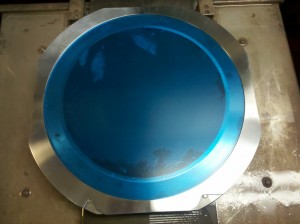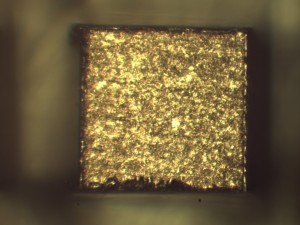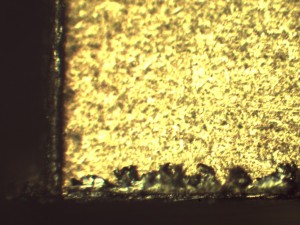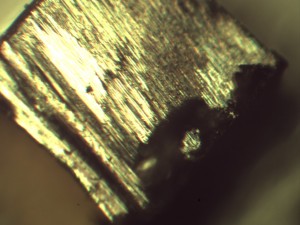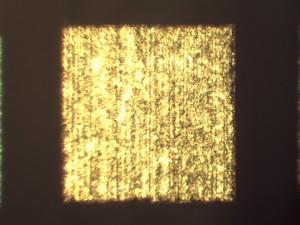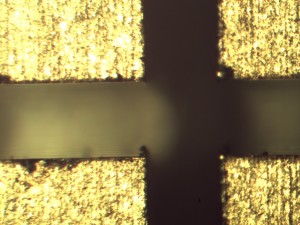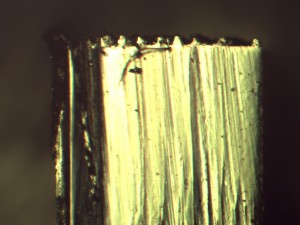The making of the integrated circuit is a long and arduous process that involves various steps and procedures. In most cases the wafer, as its called, travels to different locations before it is completed and turned into the final product. This 6, 8, or 12″ diameter wafer houses maybe thousands of tiny instruments. Devices that have been created as part of a bigger creation or as key components to perhaps the next scientific breakthrough. The wafer designs vary in complexity but can be as complex as utilizing various types of materials; from gold to copper, germanium to gallium arsenide. Wafers with soldier bumps or perhaps an intricate run way of channels and cavities. Wafers that are made up of waveguides or actual moving parts such as MEMS and much more. I will dare to say that the possibilities are inexhaustible. The microchip is truly an attribute to human kind and our hunger to better ourselves in this new technological era. With the following words I would like to offer a simplistic overview of the process while focusing on how dicing comes to play and why it is so important.
Making the silicon ingot
This process is done in a crystal pulling furnace where high purity silicon is melted in a controlled environment. Then a single crystal silicon seed is introduced, rotated and slowly pulled allowing the atoms of the pure silicon to attach to the crystal seed forming a single crystal ingot. This is a slow process with many different components such as precise temperature control as well as different kinds of dopants and pure gases to achieve the desired specifications. Needless to say, the furnace is a complex piece of machinery composed of many elements that ensure precision. This ambient is the birth place the silicon wafer! The fundamental base for most integrated circuits. Once the ingot is produced, it is polished and the crystal orientation marked by making a notch or cutting a flat on it.
Slicing and polishing
The ingot is them sliced using a wire saw or an inside diameter saw to create a wafer that is uniform in thickness. The lapping and polishing processes are done to achieve the right thickness and to eliminate any imperfections that may be present in the rough wafer. The wafers can be single side or double side polished. The polished side of the wafer is the side that will be used to make the circuitry required for any specific device. The edge of the wafer is also polished and rounded off to prevent breakage. After this the wafers are rigorously cleaned using a variety of solvents and deionized water, then dried.
Oxidation
This step is extremely important in the manufacturing of the integrated circuit. Coincidently it is a natural occurrence in silicon over time, but this process is accelerated using either oxygen or water combined with very high temperatures. This is done in an oxidation or diffusion furnace where the silicon is exposed to one of the two elements depending on what type of oxidation you want to achieve. The elements react with the wafer forming a thin layer of silicon dioxide.
Photo-lithography and the etching process
Now its time to make the circuitry in most cases composed of transistors, capacitors, resistors, and connectors. Keep in mind that these are made in minuscule scale for the trend has been for smaller and smaller devices over the years. How is this done? Well as the name of the process suggests, this is done by borrowing techniques from photography and lithography. First the wafer is coated with photo resist which is a light sensitive liquid material that is applied while the wafer is spinning to ensure an even coat. The wafer then goes through a soft bake in order for the resist to cure. A mask is made from soda lime or fused silica. This mask contains a large scale outline of the circuitry or pattern that is intended for the wafer. The coated wafer will act as the photographic paper and the mask will act as the negative. Ultra violet light passes through the transparent areas of the mask onto the wafer and the resist will react to this light. After this the wafer is developed using chemicals that will remove the exposed photo resist. The wafer then goes through an etching process where the oxidation layer that is not protected by the resist will be taken off. Finally, once the resist is no longer needed, it is removed using more chemicals. This process is repeated as necessary to achieve the wanted results. Once the wafer has been completed it generally goes through some tests to identify the working and nonworking devices. A map or a drawing of the wafer is made identifying these and sometimes the bad devices are marked on the wafer.
The dicing process
Now you have hundreds or thousands of microchips in one wafer and the only thing that stands between that wafer and the final product is a few more steps. The first thing to do now is to separate the devices from each other and this is done in the dicing process. The dicing process is a violent and dirty process by which a blade made out of diamonds bonded together by nickel, resin, or metal spin at very rapid RPM, while the wafer is driven into it at a predetermine feed rate. Dicing is a lot like cutting tile but at a smaller scale and with much more precision. In most cases a small space called a ‘street’ is accounted for in the design so that a fine blade could cut through without touching or harming the actual device. Normally the street is about 80 microns in width but this may vary and the trend is for smaller and smaller streets . In actuality with nickel bonded blades, which are the standard for dicing silicon, we can get a minimum thickness of 15 microns or .0006″. The three most important elements in dicing are: the blade, the machine, and parameters.
The dicing blade
Choosing the right blade for any particular application is crucial. These essential precision tools come in a variety of sizes, types, as well as in different abrasive or grit sizes. They also come in hubbed and hubless forms. The different types of blades are: resin bond for dicing glass, quartz, sapphire and such materials. Nickel bond for dicing silicon, gallium arsenide, germanium and indium phosphate. Metal sintered blades are good for dicing plastics, QFN packages, PCB and FR4 type materials. They all utilize diamond as an abrasive and the diamond (in most cases synthetic diamond) is what does the actual cutting. The key is in choosing the right size diamonds for the particular application at hand. When dealing with hubbed blades the exposure is to be considered to ensure that there is enough blade to cover the material and sufficient room for wear. When dealing with hubless blades the flange needs to be taken into account. The flange is a metal hub that holds the blade in place and sets it in the spindle. In choosing the right hubless blade one needs to keep in mind the ID and OD of the flange to determine the right size blade that is needed. The exposure of a hubless blade is determined by subtracting the OD of the blade from the OD of the flange and dividing that number by 2. The essential specifications for a blade are size (ID, OD),type(nickel, resin, sintered, hubbed or hubless), thickness, grit size, and exposure. Some manufacturers use different diamond concentrations and that is to be acknowledged as well.
The dicing machine
The dicing machine has evolved over the years to be very complex and accurate; in most cases with tolerances of 2 – 5 microns. It is composed among many other things of a spindle, which can come in 2, 3, or 4″ sizes; the 2″ is the most common. The spindle is attached to a ‘lead screw’ which allows it to move in the Y direction. It also moves up and down in the Z direction. The chuck, which also utilizes a vacuum, is a metal or ceramic table that moves in the X direction and it determines the feed rate. In other words the table is what drives the wafer into the blade while it spins and does the cutting. The chuck also rotates which is essential for alignment. In order for the wafer to be diced, it needs to be mounted using a ring or film frame and dicing tape. Then the wafer can go on the chuck and the vacuum is activated to prevent it from moving during the violent process. The blade is set to cut just slightly into the tape without going all the way through. This is done so that the wafer is diced completely while the tape remains intact. Among other hardware, the dicing machine is composed of optics that let you see the pattern on the wafer, as well as software that allows for programing according to the specific dicing need. The newer models come with such technological marvels as pattern recognition and automated wafer loading and unloading. As well as sensors that will perform automatic blade hight adjustments and compensate for wear.
The parameters
In dicing, parameters are paramount. The important parameters are as follows: RPM, feed rate, blade type and grit size, cooling water, and number of passes. These are determined by, material type, material thickness, street width, as well as chipping tolerances and die size. It is also very important to choose the right tape as explained in a prior post. The right combination of these parameters will ensure that the final product is a success. As time progresses the streets get smaller, specs get tighter and the over all demand for a more accurate dicing has increased. If any of these parameters is off or not adequate there will be mortal consequences for the device, such as unacceptable front side and back side chipping, improper cut profile or cut depth, cracks, dirtiness, or mis-cuts.
Cleanliness
I mentioned this process to be a dirty one because during the dicing, the silicon wafer exudes great amounts of saw residue which gets all over the place. In order to keep the devices clean one of two steps are taken. 1)The wafer is coated with photo resist prior to dicing, which is applied to the wafer like I have explained earlier, then it is baked at 100 degree Celsius for 30 minutes. Any residue that attaches to the surface of the wafer is taken off when the photo resist is removed. 2)The wafer goes through a cleaning procedure in a specialized pressure washer after dicing. This is a high power pressure washer that basically shoots deionized water at the diced wafer while it is spinning, eliminating any saw residue that might be present in the crevices of the wafer. This process is usually the last after the dicing is done and the wafer is ready for the next phase. If the photo resist option was applied, then the final step would be to clean the photo resist off the parts with a process that I will discuss at a later entry.
Pick and place; final packaging
Finally after this long enterprise and having sent the wafer through all these different procedures, the microchips are made and diced. However they are attached to dicing tape on a ring or film frame and there is still one final step. That is to remove all these individual instruments off the tape and package them for sale or assembly. This is done by the pick and place process. There are two main ways of doing this; manually or in a fully automated process. To do it manually a vacuum wand is used which is basically a pen like instrument that utilizes a vacuum to suck the die pieces off the tape. The wand has a release mechanism that lets you place the die pieces where necessary. Each individual die is picked and placed in a gel pack or waffle pack. The gel pack is a container which has a sticky membrane at its base and they come in various tackiness levels that essentially hold the device in place for transportation. The waffle pack is different in that it only has the cavities large enough to fit the individual die with no adhesive what so ever. The automated option is with a machine that can be programmed to pick any given array of die off the tape. In order to pick the right die, whether it is done manually or automatically, the drawing or map of the wafer is used as a reference to locate the working die. Then the microchips are off for final packaging or assembly.
My hope is that after reading this, the reader obtains a better understanding of this complicated process and in doing so he or she can see what goes into making the devices that make our lives so great. The integrated circuit has become a part of our daily lives and it is present in things such as our phones, computers, our cars and more. It is an essential component in our defense, our communications, and our entertainment. It is a key that has opened innumerable doors for humanity in the medical, technological, and scientific fields. It is the technological impulse that has catapulted us from a primitive past and into a great and intriguing future. Moreover the integrated circuit continues to evolve and become more efficient, making the present and future an exciting thing to think about. The thoughts of where we have come from in 50 years and where we will be at 100 years from now, thanks to this minuscule apparatus, makes us quiver with fascination, nostalgia, and wonder all at the same time. Thank you for reading.

